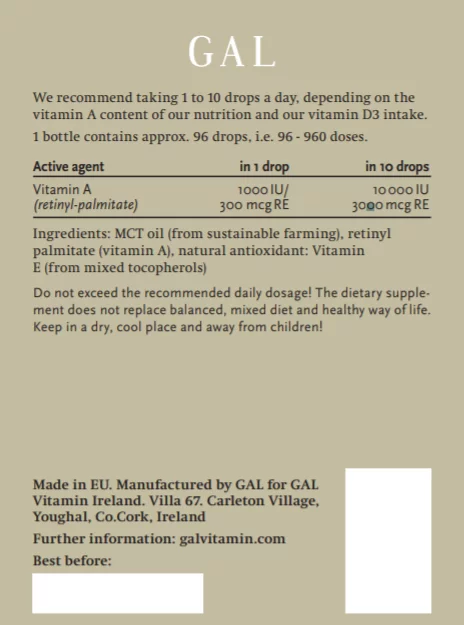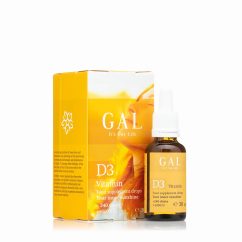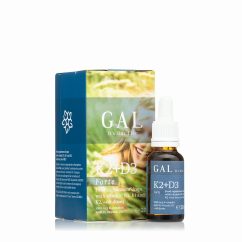
Vitamin A
It’s probably the simplest product one could imagine, still, it had to be conceived, as for many it can be a great deal of help in setting the optimal retinol: D3 ratio.
Dissolved in plain and simple retinol-palmitate MCT oil, stabilized with a bit of natural vitamin E complex.
Why retinol palmitate? (Retinol palmitate = retinyl palmitate, the latter is more correct)
Retinol is the ready form of vitamin A very well utilized by all, as it does not need to be converted by the human organism. Retinyl palmitate is virtually the only form retinol is found in food (liver), which is none other than a natural compound of the fatty acid found in the body (palmitic acid) and retinol. 90 % of vitamin A in the human and animal body is stored in the liver almost exclusively in the form of retinyl palmitate (a small quantity also in other forms related to fatty acids). The point is that nearly all vitamin A we can intake with food is retinyl palmitate.
Since, as a result of replenishing vitamin A in an organism already poor in vitamin D3, the ratio of A and D3 shifts abnormally toward vitamin A, additional vitamin A replenishment may further worsen the severe lack of D3, so based on multiple analyses, it may have adverse impacts. Replenished together with D3, on the other hand, it’s OK, and even an extreme dose of retinol is safe. Interestingly, however, in a 2003 analysis (metaanalysis), where all the former analyses of vitamin A replenishment were analyzed, the conclusion was made that neither vitamin A coming from the liver (which is retinyl palmitate) nor the retinyl palmitate replenished solved in oil, only the dry form of retinol (retinol acetate), or water-soluble or emulsified forms of retinol cause any kind of non-desired impact. There is no way to know exactly, what the reason for this is, but considering the fact that from the different forms of retinol only retinyl palmitate is natural, it’s not so surprising... This is why we selected retinyl palmitate and solved it in MCT oil.
Regardless to this, excessive retinyl palmitate replenishment is also dangerous, as its ratio compared to D3 can be displaced with it but it’s important anyway, to obtain retinol only from natural food and/or by consuming retinyl palmitate, and to avoid retinol acetate and all water-soluble, emulsified or liposomal forms, which on the basis of the referred analyses represent higher risk.
The optimal retinol: D3 ratio (expressed in IU)
Today, hardly anyone can be capable of telling the optimal ratio of vitamins A and D3, however, some important findings can be made:
- A/D3 ratio below 1:1 (meaning that more D3 is taken in) is not a problem, at least to a certain level. There is a number of analyses, where the replenishment of at least 10 thousand IU vitamin D3 is beneficial without any kind of negative impact, also in long term. In the latest study, nearly 5 thousand people were followed, who ingested 5 thousand, 10 thousand or 20 thousand IU D3 on daily basis, without anything else. Even among those taking daily 20 thousand IU D3 for 7 years - and among no one else - no negative change was observed, either in the blood count or in the blood calcium level (which is practically considered as the only side effect of D3 - by unfounded fear as it turns out). On the contrary, a number of positive changes happened in their condition/blood count. As most people typically consume less than 5 thousand IU of vitamin A (also considering carotenoids), so the ratio is apparently not problematic up to 4:1 (at least not in retinol efficient condition, with high-dosage D3 replenishment).
- Ratio exceeding 10:1 (where retinol is 10) can already be problematic. At least in an analysis, where 72 nurses were followed, it was revealed that those, whose retinol intake was at least 10 thousand IU (about half of which came from food, and the other half from replenishment), 48% more suffered pelvic bone fracture, than those consuming only 3000 IU vitamin A (largely coming from carrots, i.e. carotene). As D3 intake of people is around 500-2000 IU, even if they consume some kind of multivitamin or sunbathing at times, in case of the group with bone fracture, this ratio could have been between 10:1 and 40:1. So, up to the 10:1 ratio, it seems to be safe (at least in mild D3 deficient conditions).
- This is going to be even more theoretic: From an evolutionary point of view, the ratio seems to be optimal around 1:1, as in the case of people, who got used to regular sunbathing, D3 generation of the skin is set to the synthesis of around 4 thousand IU per day, meaning that our African ancestors obtained around 4000 IU D3 on daily basis. For approximately 3 million years, man’s predecessors were basically collectors and carnivores: they animal food included marrow, brain, bone, insects, molluscs, ocean scurvy/algae/seaweed and of course fruits/vegetables/tubers. The liver is a preferred part of the prey for the predators (unlike people, predator animals are capable of emptying retinol, they are unable to overdose it). Man, on the other hand, started hunting only 100-200 thousand years ago, but if we count the share of calories an animal’s liver+kidneys give from the volume that can be gained from eating the entire animal, then we come to the conclusion that with the daily intake of 2 to 3 thousand calories if we eat an animal “nose-to-tail”, we can get approximately 2000 IU retinol per day (besides liver and kidneys, no part of animals contain any significant amount of retinol). For the 1.1 ratios, 4000 IU retinol would be necessary, but as vegetable food also contains carotenoids, which can convert into retinol, it was OK to be above 1:1 ratio (with more vitamin A). On the other hand, considering pre-formed, ready vitamin A (retinol), the 1:1 ratio was not really attainable, let alone being exceeded, only if we’d have thrown out most of our animal food, and hunted animals mainly for their liver only... Hardly...
Those, who are interested in the topic more deeply, I recommend Gábor Szendi’s book called (A new vitamin revolution), or the book of Paul Jaminet called (Perfect Health), and the related paper of the Weston Price Foundation: https://www.westonaprice.org/health-topics/abcs-of-nutri- tion/vitamin-a-on-trial-does-vitamin-a-cause-osteoporosis/
So, as I see it in summary, one should strive to 1:1 retinol: D3 ratio, not counting the intake of carotenoids, but also ingesting plenty of them to ensure that if more retinol is needed, it can be converted from carotene. And the ratio between 1:4 and 10:1 is probably also good, especially if our vitamin K intake (K1+K2) is in order. For example, vitamin K counteracts excessive adverse impacts of D3 also without vitamin A. Not only do they prevent each other’s side effects but also help each other’s beneficial impacts.
Practical recommendations
The liver is by far the best source of retinol. Kidneys also contain a significant amount of retinol, but far less, than the liver. Retinol contents of other food products are negligible; egg yolk can be mentioned, but it isn’t worth considering, as we have to eat dozens of them on daily basis to ensure the daily minimum... Hardly anyone eats kidneys, let alone several times a week. So only the liver is worth considering...
100 grams of liver contains approximately 20 thousand IU retinol (beef and chicken liver around 10 to 20 IU, goose and duck liver around 30 to 40 thousand IU, turkey liver 60 to 70 thousand IU, whereas cod liver around 100 IU).
100 grams carrot, on the other hand, not consumed raw, but with a little fat (e.g. stewed on a little coconut fat, butter or olives), gives about 5 to 15 thousand IU retinol, depending on one’s digestion (gall/absorption) and genetics (conversion from carotene into retinol). As we cannot know, how good our organism is good at absorbing carotene and converting it into retinol, one should better calculate only 5 thousand IU for 100 grams carrots, or even less, if consuming it raw, without fat.
It is important that our body converts from carotenoids and utilizes only the retinol it needs (absorption and conversion increase in case of low retinol level, and decreases if the retinol level is normal). So, retinol cannot be overdosed using carotene.
Some examples:
If we almost never eat liver or carrots/pumpkins, then it is recommended to ingest about as much retinol as D3, or even a little more. If we consume a lot of carrots (e.g. half a kg every week), and also at least 100 to 200 grams of liver, then vitamin A is worth replenishing only in case, we consume a very high amount of D3 (e.g. 8 to 10 thousand IU).
Replenishing 4000 IU D3 every day is 28 thousand IU per week, which means that the 1:1 ratio is already reached with about 100 to 200 grams of liver per week (or also in case of consuming 600 grams of carrot per week, or e.g. weekly 100 grams of liver + 300 grams of carrots.).
Replenishment of daily 10 thousand IU D3 is 70 thousand IU per week. For this, we would have to eat as much as nearly half a kg liver or one and a half kg carrot every week (or e.g. 250 grams liver + 750 grams carrot per week).
It is sufficient to consume retinol on a weekly or even biweekly basis, you don’t have to eat it every day. What is important is that during a set time period (e.g. in one week) one should intake at least as much retinol as D3, expressed in International Units (IU). A little more is not a problem, regarding that problems begin only when the retinol level is 10 times of the D3 level (for an average man, the A: D3 ratio is well above 10:1).
If don’t like or would want to calculate all the time, then I recommend replenishing equal amounts of retinol and D3, which means that the replenishment itself should also be at a 1:1 ratio as in case of 1:1 replenishment ratio we will not reach the potentially risky 10:1 ratio even by eating liver all the time… (in addition to daily 4 thousand IU D3 + 4000 IU retinol intake, we’d have to consume 1 kg liver per week to reach the 10:1 ratio). So, if one consumes liver only a couple of times per week, I recommend 1:1 replenishment. To those eating liver more than twice a week, I recommend counting - whether they like to or not - their weekly retinol and D3 intake, and try to set it between ratios 1:1 and 3:1…
Made in the EU
Warnings
KEEP OUT OF REACH OF CHILDREN. DO NOT EXCEED RECOMMENDED DOSE.
If you are undergoing treatment for a medical condition or if you are pregnant or lactating, please consult your medical practitioner before introducing supplementary foods to your normal routine. The dietary supplement should not be used as a substitute for a varied and balanced diet or a healthy lifestyle. Store tightly closed in a cool and dry place.
Sources:
McCullough et al.: Daily oral dosing of vitamin D3 using 5000 TO 50,000 international units a day in long-term hospitalized patients: Insights from a seven-year experience. The Journal of Steroid Biochemistry and Molecular Biology. Volume 189, May 2019, Pages 228-239
Sheila M. O'Byrne and William S. Blaner: Retinol and retinyl esters: biochemistry and physiology. Thematic Review Series: Fat-Soluble Vitamins: Vitamin A. J Lipid Res. 2013 Jul; 54(7): 1731-1743.
Myhre et al.: Water-miscible, emulsified, and solid forms of retinol supplements are more toxic than oil-based preparations. The American Journal of Clinical Nutrition, Volume 78, Issue 6, December 2003, Pages 1152–1159
Feskanich D et al. Vitamin A intake and hip fractures among postmenopausal women. JAMA, The Journal of the American Medical Association 2002 Jan 2;287(1):47–54,
Spiesman IG. Massive doses of vitamins A and D in the prevention of the common cold. Archives of Otolaryngology-Head & Neck Surgery 1941(Oct);34(4):787–791
Fu X et al. 9-Cis retinoic acid reduces 1alpha,25-dihydroxychole- calciferol-induced renal calcification by altering vitamin K-dependent gamma-carboxylation of matrix gamma-carboxyglutamic acid protein in A/J male mice. Journal of Nutrition 2008 Dec;138(12):2337–41, http://pmid.us/19022954. Hat tip to Chris Masterjohn: www.facebook.com/note. php?note_id=112375358783617.

-Allergen-free
- Glutenfree
- Egg-free
- Soy allergen-free
- Dairy and lactose-free
- Free of sulfur dioxide
- Sugar-free
- GMO-free
- Vegetarian
- Vegan
- RSPO certified MCT
- FSC paper material (CO31340)
- Packaging from carbon-neutral production
- 100% recyclable packaging
Green: The product has the described property
Red: The product does not have the described property

Brief and precise summary of Vitamin A
Vitamin A can have a bad reputation, even though it’s an essential, fat-soluble vitamin which plays a vital role in growth, immunity, and hormone production. It works in tandem with other fat-soluble vitamins, and special care must be taken of its proportion to vitamin D3. This is at the root of vitamin A’s disrepute: a large dose of vitamin A can have a negative effect if one suffers from vitamin D deficiency.
Vitamins A and D complement each other
They are most effectively applied in a combined form, as they enhance rather than block each other’s effect.
Various controversies can be read about vitamins A and D. Some claim that vitamin A inhibits vitamin D’s functions, while others merely ignore their interaction and push vitamin D on its own.
Vitamin A is necessary for healthy skin
More and more people realize how important it is for healthy skin to not only protect it externally but to nourish it with vitamins and minerals internally. Various synthetic vitamin A derivatives have long been used to treat skin diseases, but there’s been a lot of mystery around what vitamin A does exactly.
The role of vitamin A in development
Vitamin A is indispensable in growth and development: without vitamin A, the level of sex hormones decreases, and in the case of children, sexual maturation and growth slow down. Animal studies prove that the body does not produce a sufficient amount of testosterone if vitamin A levels are deficient. Therefore, vitamin A is important for all who would like to gain muscle.
Vitamin A supports our immune system
The usage of vitamin A in fighting infection has an agelong tradition. Multiple clinical trials conducted in the first half of the 20th in connection with vitamin A observed a decrease in the amount and severity of infections in most cases.
Should we fear Vitamin A overdose?
Based on the results of a few observational studies and meta-analyses, many people have drawn attention to the dangers of vitamin A overdose, but let's see how well-founded these claims really are.
Vitamin A deficiency could play a role in depression









